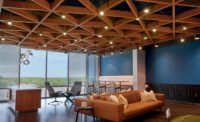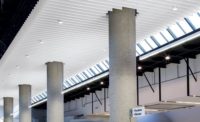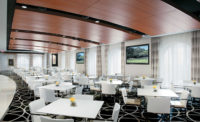The Gulf Canada Square Food Court was beginning to show its age and its food service tenants were concerned that they might be losing business to other fast-food venues in Calgary’s busy downtown business district.
Deciding it was time for an update, owners of the 20-story Gulf Canada Square building, which is connected to other buildings in the downtown area by the city’s elevated Plus 15 walkway, commissioned Stantec Architects of Calgary to come up with a plan for refreshing the space that would work with the existing seating configuration.
Utilizing Shape
Working with the curvilinear shape of the room, the design team replaced the existing drywall ceiling with a dynamic, new wood ceiling that radiates out in a sunburst design above the food court. “The space lent itself to an oval shape,” says project architect Craig Ainsworth, “so we just played off that shape and the placement of the existing structural columns to develop this large, oval-shaped ceiling with lines radiating out from the center.”
Complex Panel Design
The 3,400-square-foot ceiling is made up of 234 uniquely-shaped custom WoodWorks Access panels from Armstrong Ceiling & Wall Solutions that when installed together created the oval-shaped design. “The panels get gradually smaller as they approach the center,” says Ainsworth. “No panel was the same size or shape. It was very complex.”
The design team was tasked with finding a solution that was not only visually exciting but would allow access to the mechanical components in the plenum. “Each of the wood panels is easily removable to service the equipment,” says Ainsworth.
The wood panels feature a dark cherry finish and the grain pattern on each individual panel was customized to flow outward from the center of the oval. “The grain on each individual panel was laid up on the face of the panel to create a grain pattern that flowed from the center of the oval, to the perimeter, in all directions when the ceiling is viewed as a whole,” explains Jerry Grabusky, Architectural Specialties project manager for Armstrong Ceilings, who worked with the design team on the project.
Energy Efficiency
With a consistent six inch reveal between each of the panels, the design team was able to incorporate a new energy-efficient lighting layout and take advantage of the acoustical properties of the new ceiling. “Because the sound could now go up into the ceiling plenum space above, we were able to take advantage of an acoustic treatment on the back of the panels,” explains Ainsworth.
Like Building a Spider Web
Situated on the second floor of the building adjacent to the Plus 15 passageway, the food court remained open during the renovation and a temporary enclosure was erected to protect the public and shield the construction area from view.
Working from a scaffold platform above the food court, Midwest Group, the Calgary contractor who installed the ceiling, established the lines for the drywall grid system, laid out the panel suspension hardware, and fastened the hardware to the drywall grid system at the specific location for each individual panel. “The suspension system ran continuous throughout the ceiling,” adds Grabusky, “and the hanging hardware located on the back of each panel had to be coordinated with the grid location running above.” Armstrong Ceilings provided all the parts for the ceiling installation.
The installation required that great attention be paid to the details. “We had a different shop drawing for each panel,” says Dan McMahon, operations manager for Midwest Group. “We worked our way from the inside out so we would know which panel went where. It was almost like building a spider web. It took a bit of tweaking to make the ceiling look like it was flowing, but basically it all came down to proper layout at the beginning.”
Strategic Use of Color
The drywall grid was painted black to obscure the mechanical components in the ceiling. “Everything else behind the ceiling disappears,” says Ainsworth, “so that these wood panels became the predominant plane of the ceiling.”
Four-inch curved wood trim was attached to the edge of the panels on the perimeter of the ceiling to provide a finished look.
A Simpler Solution
The design team had initially considered using custom millwork, but found the WoodWorks Access panels to be a simpler solution. “They provided a better solution because of their lightweight nature and their acoustic properties,” says Ainsworth. “Millwork would have been more expensive, much heavier, and much more difficult to specify in detail. The WoodWorks system actually simplified the challenge of providing a solution.”





Report Abusive Comment